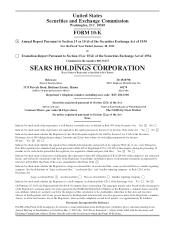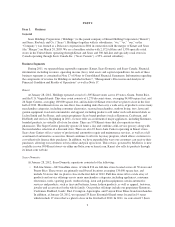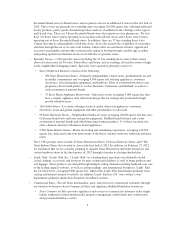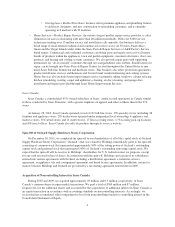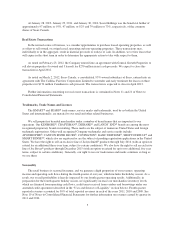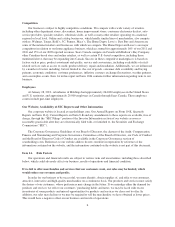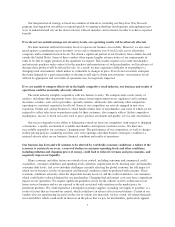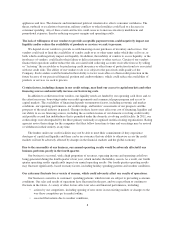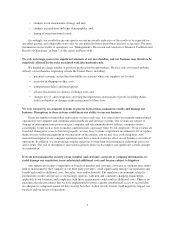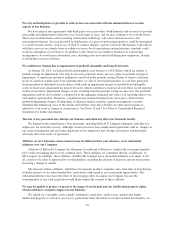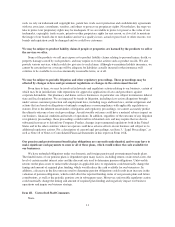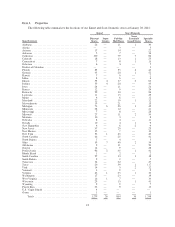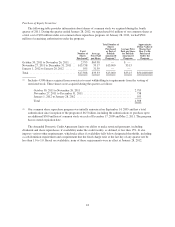Sears 2011 Annual Report Download - page 8
Download and view the complete annual report
Please find page 8 of the 2011 Sears annual report below. You can navigate through the pages in the report by either clicking on the pages listed below, or by using the keyword search tool below to find specific information within the annual report.appliances and tires. The domestic and international political situation also affects consumer confidence. The
threat, outbreak or escalation of terrorism, military conflicts or other hostilities could lead to a decrease in
consumer spending. Any of these events and factors could cause us to increase inventory markdowns and
promotional expenses, thereby reducing our gross margins and operating results.
The lack of willingness of our vendors to provide acceptable payment terms could negatively impact our
liquidity and/or reduce the availability of products or services we seek to procure.
We depend on our vendors to provide us with financing on our purchases of inventory and services. Our
vendors could seek to limit the availability of vendor credit to us or other terms under which they sell to us, or
both, which could negatively impact our liquidity. In addition, the inability of vendors to access liquidity, or the
insolvency of vendors, could lead to their failure to deliver inventory or other services. Certain of our vendors
finance their operations and/or reduce the risk associated with collecting accounts receivable from us by selling
or “factoring” the receivables or by purchasing credit insurance or other forms of protection from loss associated
with our credit risks. The ability of our vendors to do so is subject to the perceived credit quality of the
Company. Such vendors could be limited in their ability to factor receivables or obtain credit protection in the
future because of our perceived financial position and creditworthiness, which could reduce the availability of
products or services we seek to procure.
Certain factors, including changes in our credit ratings, may limit our access to capital markets and other
financing sources and materially increase our borrowing costs.
In addition to credit terms from vendors, our liquidity needs are funded by our operating cash flows and, to
the extent necessary, borrowings under our credit agreements and commercial paper program and access to
capital markets. The availability of financing depends on numerous factors, including economic and market
conditions, our operating performance, our credit ratings, and lenders’ assessments of our prospects and the
prospects of the retail industry in general. Changes in these factors may affect our cost of financing, liquidity and
our ability to access financing sources, including the accordion feature of our domestic revolving credit facility
and possible second lien indebtedness that is permitted under the domestic revolving credit facility. In 2011, our
credit ratings were downgraded by the three primary nationally recognized statistical rating organizations. Rating
agencies revise their ratings for the companies that they follow from time to time and our ratings may be revised
or withdrawn in their entirety at any time.
The lenders under our credit facilities may not be able to meet their commitments if they experience
shortages of capital and liquidity and there can be no assurance that our ability to otherwise access the credit
markets will not be adversely affected by changes in the financial markets and the global economy.
Due to the seasonality of our business, our annual operating results would be adversely affected if our
business performs poorly in the fourth quarter.
Our business is seasonal, with a high proportion of revenues, operating income and operating cash flows
being generated during the fourth quarter of our year, which includes the holiday season. As a result, our fourth
quarter operating results significantly impact our annual operating results. Our fourth quarter operating results
may fluctuate significantly, based on many factors, including holiday spending patterns and weather conditions.
Our sales may fluctuate for a variety of reasons, which could adversely affect our results of operations.
Our business is sensitive to customers’ spending patterns, which in turn are subject to prevailing economic
conditions. Our sales and results of operations have fluctuated in the past, and we expect them to continue to
fluctuate in the future. A variety of other factors affect our sales and financial performance, including:
• actions by our competitors, including opening of new stores in our existing markets or changes to the
way these competitors go to market online,
• seasonal fluctuations due to weather conditions,
8

